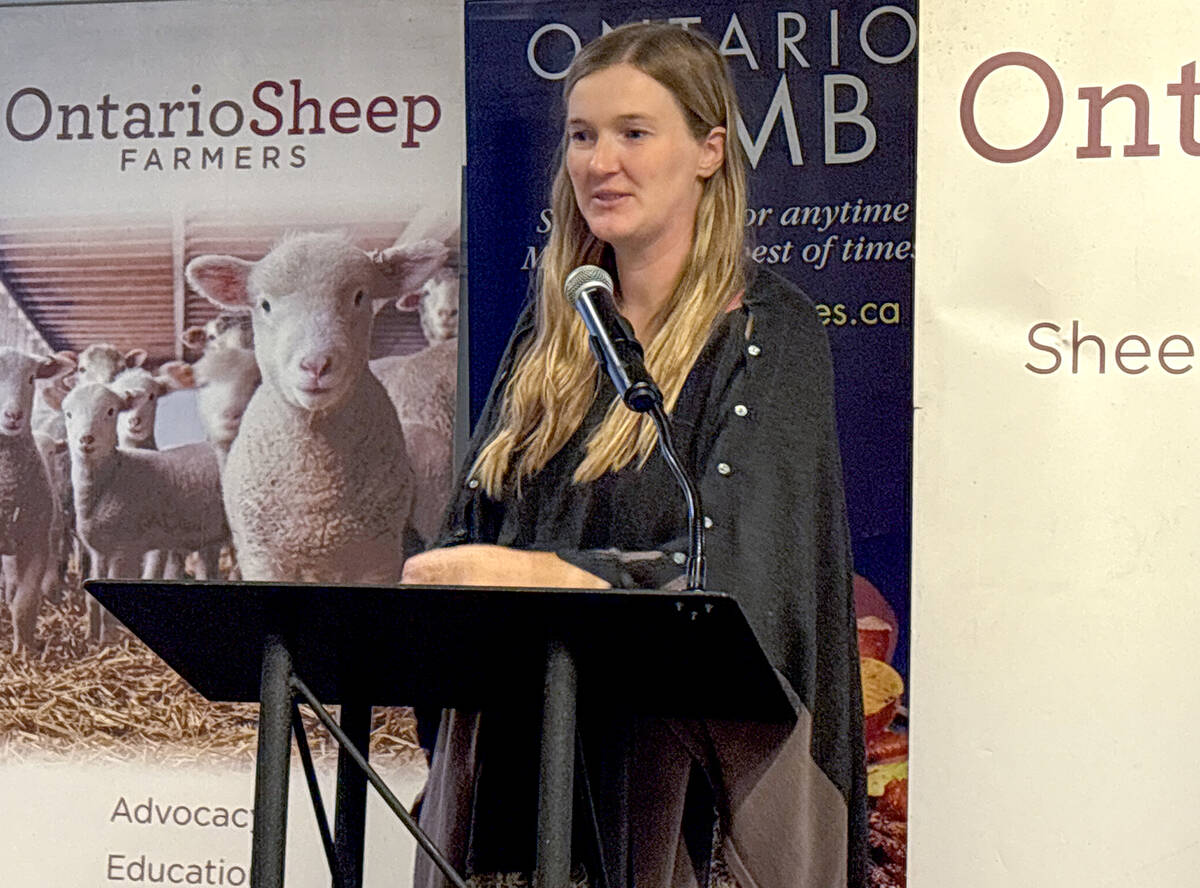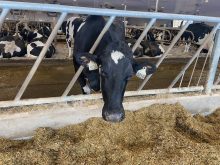Nitrogen fertilizer is a cornerstone of crop production. It’s also become a hot political topic, with market volatility, emission reduction demands, geopolitics and a slew of other factors keeping it in the headlines.
While nitrogen prices remain high, there are strategies growers can employ to reduce nitrogen use without sacrificing profits or yields.
Several researchers explained how Ontario growers can use nitrogen more efficiently at the 2023 Ontario Agricultural Conference in Ridgetown last month.
Read Also

Footflats Farm recognized with Ontario Sheep Farmers’ DLF Pasture Award
Gayla Bonham-Carter and Scott Bade, of Footflats Farm, win the Ontario Sheep Farmers’ 2025 DLF Ontario Pasture Award for their pasture management and strategies to maximize production per acre.
Why it matters: Using nitrogen more efficiently is key to reducing costs while maintaining crop yields.
Craig Drury, soil biochemist with Agriculture and Agri-Food Canada and John Lauzon, crop science professor at the University of Guelph, said to be profitable in times of high nitrogen prices, maximizing yields is not the best strategy.
In fact, doing so costs more than the perceived gain in yield, while also increasing fertilizer loss, they said.
Nitrogen is lost through several means, such as tile drainage and surface runoff, nitrate leaching and ammonia volatilization. Drury suggests growers picture “a pipe with lots of holes,” where the first aperture is volatilization, followed by nitrification and a series of potential losses from excess moisture, erosion, and so on.
[RELATED] OMAFRA discontinues annual nitrogen survey
Whatever remains is what’s available to the plant.
Increasing the amount of available nitrogen requires what Drury calls “valves,” or safety checks at each stage of loss. These include inhibitors, as well as changes in application strategy.
However, practices intended to increase the longevity of nitrogen fertilizer have to be carefully leveraged to avoid increasing the potential for loss at different stages.
A urease inhibitor may slow the volatilization process, for example, but can increase the later risk of losses as soil pH becomes more basic, and ammonium turns into nitrate.
Some of the best results in Drury and Lauzon’s field research have come from the use of more than one nitrogen inhibitor. Incorporation after early-season broadcast application also drastically reduces volatilization losses, although the presence of cracks by which ammonia can escape, such as in overly dry conditions, still results in significant losses.
The same applies to injecting fertilizer, but applying nitrogen in two bands rather than one reduces the concentration of the nutrient, resulting in less volatilization, even in overly dry conditions.
Experiments combining nitrogen inhibitors and dual-band application have shown loss reductions ranging from 72 to 97 per cent in volatilization, which results in loss of nitrogen to the air.
“It pays to both inject and add inhibitors to reduce loss,” said Drury.

Knowing weather patterns and the unique characteristics of each field is also critical. Areas prone to excessive moisture retention are at risk for nitrogen loss through groundwater. Hot days, not enough moisture, high winds – these can all exacerbate losses through volatilization, particularly just after application.
Lauzon said manure trials under such conditions have shown near complete ammonium nitrogen loss within three days of application.
Drury reiterated the value of using both urease and nitrification inhibitors and improving placement. The use of all three can have a yield benefit, but growers still have to keep their soil and unique climate in mind.
“Understand how nitrogen is lost on your farm … There’s a whole suite of solutions or tools you can pick and choose to match your scenario,” he said.
Finding the right rate
Finding the right nitrogen rate for a given piece of land is another challenge, said Josh Nasielski, assistant professor of agronomy and crop physiology at the University of Guelph. Consistently opting for more rather than less has been the historical norm, but years of field data indicate that strategy is often counterproductive economically and environmentally.
A decade-long Ontario corn study, for example, shows between 160 and 180 units of nitrogen nets within $10 per acre of the maximum profit. The incorrect conclusion to draw from this result, said Nasielski, is that extra nitrogen is needed every year to jump the last $10 hurdle.
The correct conclusion? Determine what will net high profits 80 per cent of the time, and only top up with additional nutrients if necessary in a given year.
Nasielski said growers can figure out the ballpark rate that works for them by conducting delta yield strip trials — using a strip in a field to compare a very high and very low nitrogen rate. The yield difference between the two indicates yield response.
Inputting the data in the N-Rate Evaluator tool available on GoCorn.net will provide a reliable range estimate.
He said the tool can also help account for variances within the field, as well as the value of “free nitrogen” in the soil.
“Can you get 220-bushel corn with just starter nitrogen? I probably would have said no … but it turns out it is true. That’s what these delta yield trials can do. It shows you how much nitrogen you’re getting for free.
“I’m not saying this is true for all of Ontario …but it’s nice to know what your rotation, what your cover crops, what your soil texture, organic matter mineralization, residue, any amendments you’re adding — what that’s giving you for free.”
Measuring soil performance
Accounting for in-field variability is the next step in reducing fertilizer emissions and costs, according to Deb Campbell, agronomist and owner of Agronomy Advantage Inc.
Joining Nasielski on stage at the Ontario Agricultural Conference, Campbell encouraged the use of SWAT (soil, water, and topography) maps to “dial-in nitrogen” to the landscape.
Identifying different zones allows growers to change strategies based on need and avenue of potential loss. Campbell said in-season soil and plant tissue analysis helps determine available nutrient levels and how well crops are responding. Adding NDVI imagery to measure biomass supports mid-season assessments by confirming what’s being observed at the field level, she said.
“Forty per cent of nitrogen you put on ends up in the grain. That’s an alarming number,” she said.
“Where does the rest of it go? At $1,200 a tonne, where is the $800 going? When we think about disease management, pest management, integrated pest management, we’re monitoring and assessing all season long. Why aren’t we doing that with nitrogen?”
Setting realistic yield goals based on the proven potential of different soil zones is a critical part of effectively managing nutrients by zone, she said.
“That’s a key piece of precision agriculture, knowing your soils and how they perform. The goal [is] to be more profitable at the end of the day. Any time we’re increasing nitrogen use efficiency, we’re reducing losses. They go hand in hand.”
A fifth ‘R’ in 4R management
Claudia Wagner-Riddle, professor at the University of Guelph’s School of Environmental Sciences, said from her perspective, the role of soil as a provider of nitrogen must be elevated in conventional approaches to agronomy.
She called on attendees to focus on a fifth management “R” — rotation, for improved soil health, crop diversity and cover crop diversity.
“In the long term, you really want to build up soil organic matter, improve the resilience of your system and rely more on biology to provide the nitrogen as opposed to adding it synthetically,” said Wagner-Riddle.
“We need to move away from the idea that more is better, to just managing it better.”
She said the need to do so is ever-more important as government policy seeks to limit a large portion of crop-production emissions. Continued movement toward managing the right time, source and place will reduce the need to focus on rate.
“Optimizing nitrogen use through mitigation is really reducing the leaks … It’s really about how much you’re putting in and how much you’re getting out.”















